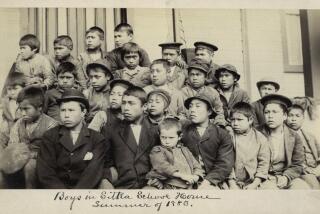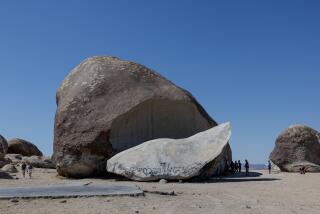With Alcatraz Takeover, Indians Staked Claim to National Attention
SAN FRANCISCO — Standing on the wave-bitten cliffs of Alcatraz, foghorn booming sadly out to sea, poet-performer John Trudell looks into the soft gray sky and sees 30 years into the past.
Not much is left of those days when a group of Native Americans staked a claim to national recognition on “the Rock,” clinging to its barren slopes for 19 months. A faded red sign--”INDIANS WELCOME”--painted on the old prison walls is a lonely relic of the occupation that began Nov. 20, 1969.
But the legacy of Alcatraz remains.
“What we did was pretty significant to me in many ways, and I learned very much from it,” says Trudell. “I learned how we could function as a community.”
*
The first occupation of Alcatraz happened in March 1964, a year after the island’s famous prison closed. It lasted four hours before the Coast Guard moved in. There was a second, also short-lived, attempt on Nov. 9, 1969.
Then, on Nov. 20, Richard Oakes and about 100 others hitched midnight boat rides from nearby Sausalito and landed, claiming a discoverer’s right to the island “for as long as the rivers run and the sun shall shine.”
Satirically, they offered to buy the island with glass beads and red cloth.
Overnight, the occupiers, “Indians of All Tribes,” became a cause celebre.
Jane Fonda donated generators. The restaurants of tourist mecca Fisherman’s Wharf arranged Thanksgiving dinner.
“No one really expected the media thing to happen the way it did,” Trudell says. “It went global.”
Blessed, at first, with electricity and a water barge left by the Government Services Administration, which had authority over the island, the occupiers set up housing, a school, a clinic, even a sweat lodge.
They demanded a deed to the island, where they wanted to establish a Native American university, a cultural center and a museum.
Government officials refused, but shied away from direct confrontation, deciding instead to hunker down for a waiting game.
Trudell got to the island around Thanksgiving 1969. A radio-television broadcast student, he began broadcasting island updates--”Radio Free Alcatraz”--from a transmitter donated by Berkeley community radio station KPFA.
“It was an adventure,” he says.
Millie Ketcheshawno, another veteran of the occupation, recalls that same spirit of bold enterprise.
“I wasn’t worried at all. I was very happy,” she says. “I remember it was very exciting.”
They weren’t always warm or comfortable. Sometimes there wasn’t enough to eat.
“But,” she says with a smile, “everybody got something.”
*
For a while the occupation was big news. Public support helped keep food and water flowing.
Then the movement started to crumble. Some of the college students went back to school; some of the newcomers didn’t share the ideals of the original occupiers. Oakes left the island after his 13-year-old stepdaughter fell down a stairwell and died.
Meanwhile, the government shut off power and removed the water barge. Shortly after that, fire broke out and several historic buildings were destroyed.
On June 11, 1971, after months of negotiations, a landing force of federal agents took the last 15 people off the island.
*
The occupiers of Alcatraz didn’t get to keep the island. They got something bigger--national attention for what was happening to American Indians.
“We were the statistics America was talking about--the 44-year life expectancy, all this stuff,” says Trudell.
After Alcatraz, there were more than 70 occupations as the American Indian movement grew.
“They inspired a young generation of American Indian activists to go on to do great things,” says Troy Johnson, a professor of history at Cal State Long Beach who wrote a book about the occupation. “American Indian people would not be where they are today if it had not been for Alcatraz.”
Those who were at Alcatraz went on to become attorneys, doctors, professors, Johnson says. One, Wilma Mankiller, became chief of the Cherokee Nation.
Trudell, who left the island shortly before the June eviction, worked with the American Indian Movement for several years.
Tragedy struck in 1979, when his wife, three children and mother-in-law were killed in a fire at their home on a Nevada reservation. About 12 hours earlier, Trudell had burned a U.S. flag in a symbolic protest in Washington, D.C. Authorities called the fire an accident; Trudell believes it was instigated by the government in retaliation.
He sought solace in words, writing and publishing a book of poetry. Later, he began reciting against a backdrop of music, creating a unique blend of rock ‘n’ roll and poetry. Along the way came a film career: He played the character “Jimmy Looks Twice” in the 1992 movie “Thunderheart.”
His latest album was produced by his friend Jackson Browne. It is called “Blue Indians.”
*
On a chilly fall day, Trudell is back on Alcatraz, checking arrangements for a concert marking the 30th anniversary.
The famously bleak island is at its most inhospitable--cold winds scour its bony flanks, choppy bay waters slap at the rocks below.
But Trudell’s memories are lit by reflections of the days when American Indian pride burned brightly here.
“Whatever our struggle was about, whatever it is about,” he says, “I learned that it’s the right struggle.”
More to Read
Sign up for Essential California
The most important California stories and recommendations in your inbox every morning.
You may occasionally receive promotional content from the Los Angeles Times.










